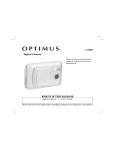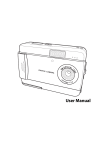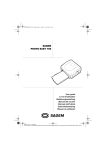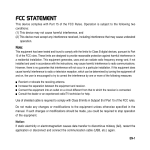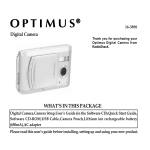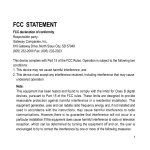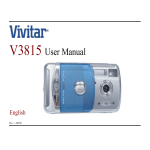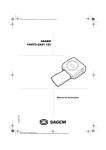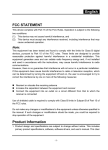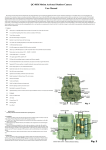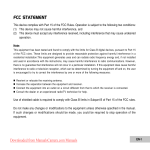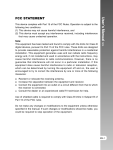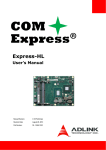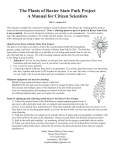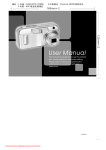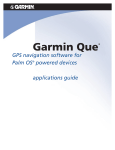Download DS5080-E-NB with pictbridge
Transcript
READ THIS FIRST Trademark Information Microsoft® and Windows® are U.S. registered trademarks of Microsoft Corporation. Pentium® is a registered trademark of Intel Corporation. Macintosh is a trademark of Apple Computer, Inc. SDTM is a trademark. Photo Explorer and Photo Express are trademarks. Other names and products may be trademarks or registered trademarks of their respective owners. Product Information Product design and specifications are subject to change without notice. This includes primary product specifications, software, software drivers, and user’s manual. This User Manual is a general reference guide for the product. The illustrations in this manual are for the purpose of explanation and may differ from the actual design of your digital camera. The manufacturer assumes no liability for any errors or discrepancies in this user manual. For user manual and driver updates, refer to our website. 1 SAFETY INSTRUCTIONS Read and understand all Warnings and Cautions before using this product. Warnings If foreign objects or water have entered the camera, turn the power OFF and remove the batteries. Continued use in this state might cause fire or electric shock. Consult the store of purchase. If the camera has fallen or its case has been damaged, turn the power OFF and remove the batteries. Continued use in this state might cause fire or electric shock. Consult the store of purchase. Do not disassemble, change or repair the camera. This might cause fire or electric shock. For repair or internal inspection, ask the store of purchase. Do not use the camera in areas near water. This might cause fire or electric shock. Take special care during rain, snow, on the beach, or near the shore. Do not place the camera on inclined or unstable surfaces. This might cause the camera to fall or tilt over, causing injury. Keep the batteries out of the reach of children. Swallowing batteries might cause poisoning. If the battery is accidentally swallowed, immediately consult a physician. Do not use the camera while you are walking, driving or riding a motorcycle. This might cause you to fall over or result in traffic accident. 2 Cautions Insert the batteries paying careful attention to the polarity (+ or –) of the terminals. Inserting the batteries with its polarities inverted might cause fire and injury, or damage to the surrounding areas due to the battery rupturing or leaking. Do not fire the flash close to anyone’s eyes. This might cause damage to the person’s eyesight. Do not subject the LCD monitor to impact. This might damage the glass on the screen or cause the internal fluid to leak. If the internal fluid enters your eyes or comes into contact with your body or clothes, rinse with fresh water. If the internal fluid has entered your eyes, consult a physician to receive treatment. A camera is a precision instrument. Do not drop it, strike it or use excessive force when handling the camera. This might cause damage to the camera. Do not use the camera in humid, steamy, smoky, or dusty places. This might cause fire or electric shock. Do not remove the battery immediately after long period of continuous use. The battery becomes hot during use. Touching a hot battery might cause burns. Do not wrap the camera or place it in cloth or blankets. This might cause heat to build up and deform the case, resulting in fire. Use the camera in a well-ventilated place. Do not leave the camera in places where the temperature may rise significantly, such as inside a car. This might adversely affect the case or the parts inside, resulting in fire. Before you move the camera, disconnect cords and cables. Failure to do this might damage cords and cables, resulting in fire and electric shock. 3 Notes on Battery Usage When you use the battery, carefully read and strictly observe the Safety Instructions and the notes described below: Different battery types and surrounding temperatures may affect the battery performance. Avoid using batteries in extremely cold environments as low temperatures can shorten the battery life and reduce camera performance. Using the new rechargeable battery or rechargeable battery that has not been used for an extended period of time (the battery that passed the expiry date is an exception) might affect the number of pictures that can be taken. Therefore, to maximize its performance and lifetime, we recommend that you fully charge the battery and discharge it for at least one complete cycle before use. The battery may feel warm after long period of continuous use of the camera or the flash. This is normal and not a malfunction. The camera may feel warm after long period of continuous use. This is normal and not a malfunction. If the battery is not to be used for a long period of time, remove it from the camera to prevent leakage or corrosion. If the battery is not to be used for a long period of time, store it after no battery power left. If the battery is stored for a long time in a fully charged state, its performance may be impaired. Always keep the battery terminals in a clean state. Risk of explosion if battery is replaced by an incorrect type. Dispose of used batteries according to the instructions. 4 CONTENTS INTRODUCTION..............................................7 Overview.........................................................7 Package Contents..........................................8 Optional Accessories......................................8 COMPONENTS GUIDE...................................9 Front View......................................................9 Rear view.......................................................10 LED Indicators...............................................11 Scene Modes.................................................12 LCD Monitor Information................................13 PREPARING YOUR CAMERA........................18 Installing the Battery......................................18 Charging the Battery......................................19 Loading an SD Memory Card .......................20 Setting the Date and Time............................ 21 Choosing the Language................................21 Attaching the Camera Strap..........................22 BASIC FUNCTIONS.......................................23 Turning the Power On................................... 23 Turning the Power Off................................... 23 Using the LCD Monitor.................................. 24 Using the Normal Mode................................. 25 Adjusting the Zoom........................................26 Using the Flash.............................................27 Using the Self-Timer.......................................29 Using the Macro Mode.................................. 30 Setting the Image Resolution and Quality..... 31 SELECTING PHOTOGRAPHY MODE............33 Auto Mode.......................................................33 Sports Mode.................................................... 34 Night Scene Mode...........................................35 Portrait Mode...................................................36 Landscape Mode.............................................37 Backlight Mode................................................38 MOVIE MODE..................................................39 IMAGE PLAYBACK..........................................40 Single Image Playback....................................40 Magnifying Images........................................... 41 Viewing Nine Images At A Time......................42 Viewing Video Clips......................................... 43 Automated Playback (Slide Show) ........43 Protecting Images........................................... 44 DELETING IMAGES........................................45 Deleting Images/Video Clips Singly.................45 Deleting All Images/Video Clips.......................46 Formatting an SD Memory Card or Internal Memory...........................................................47 SETTING THE DPOF...................................48 CONNECTING THE CAMERA DIRECTLY TO THE PRINTER FOR PRINTING IMAGES (PICTBRIGDE FUNCTION).............................49 5 TRANSFERRING RECORDED IMAGES/VIDEO CLIPS TO YOUR COMPUTER........................51 Step 1: Install the USB Driver........................52 Step 2: Connecting the Camera to Your Computer....53 Step 3: Downloading Recorded Images/Video Clips...............................................................54 SOFTWARE INSTALLATION...........................55 Installing Photo Explorer................................55 Installing Photo Express................................56 USING THE DIGITAL CAMERA AS A PC CAMERA........................................................57 Step 1: Install the PC camera driver..............57 Step 2: Connect the digital camera to your computer.........................................................58 Step 3: Run your application software (i.e. Windows NetMeeting)......................................58 LIST OF MENU OPTIONS.............................59 Capture Menu...............................................59 Playback Menu.............................................65 Video Menu....................................................66 Setup Menu (in Capture/Video/Playback Menu)...67 CAMERA SPECIFICATIONS...........................69 TROUBLESHOOTING.....................................70 6 INTRODUCTION Overview Your new stylish digital camera delivers high quality, 2560 x 1920 resolution images using a 5.0 Megapixels CCD sensor. Using the 1.7" TFT color image LCD monitor, you can compose images and then examine them in detail. An auto-flash sensor automatically detects the shooting (lighting) conditions and determines whether the flash should be used. This feature helps ensure that your images turn out right. 32 MB internal memory lets you capture and store images without the need for an additional memory card. However, you may wish to expand the memory capacity by using an external memory card. In addition to still images, you can record short videos by using the movie function. Images you have taken can be downloaded to your computer using the USB cable. You can enhance and retouch your images on your computer by using the provided editing software, or image editing software you may already own. You may share your images with your friends via e-mail, in a report, or on a website. DPOF functionality allows you to print your images on a DPOF compatible printer by simply inserting the memory card. 7 Package Contents Carefully unpack your camera and ensure that you have the following items. In the event that any item is missing or if you find any mismatch or damage, promptly contact to your dealer. 8 Digital Camera User’s Manual USB Cable 1 x Traveler Lithium battery 1 x Tripod Camera Strap Software CD-ROM Camera Pouch 1 x Traveler adapter COMPONENTS GUIDE Front View 2 3 4 1 5 7 1. Strap eyelet 5. Lens 2. Lens cover 6. Microphone 3. Shutter button 7. Self-timer LED 6 4. Flash 9 Rear view 12 10 9 11 8 7 6 K O 1 5 2 3 1. DC IN 5V terminal( -/+ ) 2. Focus switch Macro mode Normal mode 3. USB terminal 4. Tripod socket 5. Battery/SD card cover 6. OK OK button Zoom button 4 7. TArrow button (Down) MODE Mode button 8. XArrow button (Right) Flash button 9. WArrow button (Left) Self-timer button 10. SArrow button (Up) MENU Menu button 11. LCD monitor 12. Status LED 10 LED Indicators Indicator Status Description/Activity Sound Status LED None The camera is powering up Yes *(1) Status LED Solid green The camera is powered and ready No Status LED Blinking green Charging the flash No Status LED Blinking green Image is being recorded to the memory card No Status LED Solid green USB communication/transfer in progress No Status LED Solid green The camera is ready to record images Yes *(1) (or movies) Self-timer LED Blinking red The self-timer function is activated Yes *(Sec) ---- ---- Button event Yes *(1) (1) The camera sounds one beep. (Sec) The self-timer sounds 10 beeps for 10 seconds, 5 beeps for 5 seconds. 11 Scene Modes Select the scene mode suitable for the occasion or situation. Mode 1. [ A ] Auto mode Description Select this option to leave all the adjustments to the camera and take images casually. 2. [ ] Sports mode Select this option to capture fast-moving subjects. 3. [ ] Night Scene mode Select this option to take images of people against dark or nighttime background. 4. [ 12 ] Portrait mode Select this option to make people stand out with the background out-of-focus. 5. [ ] Landscape mode Select this option to capture images of distant scenery or landscapes. 6. [ ] Backlight mode Select this option to brighten subjects that are backlit and would come out dark if no flash was used. LCD Monitor Information These indicators are displayed when recording still images: 1. Scene mode [ A ] Auto mode 7 7. ISO speed [ No icon] Auto [ ] Sports mode [ ISO 100 ] 100 [ ] Night Scene mode [ ISO 200 ] 200 ] Portrait mode [ [ ] Landscape mode [ ] Backlight mode 8. Sharpness High [ H ] [ 2. Image quality ] Fine [ [ ] Normal [ ] Economy 3. Image size [ 7 ] 3072x2304 (interpolation) [ 5 ] 2560x1920 [ 3M ] 2048x1536 [ ] 1280x960 [ ] 640x480 L [ 4. Remaining pictures 5. [ ] Card indicator 6. Battery level ] Fully battery level [ [ ] Fairly consumed [ ] Nearly exhausted [ ] Virtually no battery power ] Medium ] Low 9. Color [ ] Full Color [ ] Black & White [ ] Sepia 10. Saturation ] High [ [ ] Medium [ ] Low 13 These indicators are displayed when recording still images: 7 11. Flash mode ] [ [ [ A [ A Fill flash (on) 14. White balance [ No icon] Auto ] Flash off [ ] ] Automatic flash [ ] ] Red-eye reduction [ ] Tungsten [ ] Fluorescent 12. [ Daylight Cloudy ] Self-timer mode 15. EV compensation 13. [ 14 ] Macro mode icon These indicators are displayed when playing images back: 2 of 10 1. Playback mode ] Card indicator 2. [ 3. Battery level ] Fully battery level [ [ ] Fairly consumed [ ] Nearly exhausted [ ] Virtually no battery power 4. [ ] Protect indicator 5. [ ]DPOF icon 15 These indicators are displayed when recording video clips: REC 1. 16 12:20 Movie mode 2. Recording indicator 3. Video counter 4. 5. ] Card indicator [ Battery level [ ] Fully battery level [ ] Fairly consumed [ ] Nearly exhausted [ ] Virtually no battery power These indicators are displayed when playing video clips back: 00:52 2 of 10 1. Playback mode 2. Battery level [ ] Fully battery level [ ] Fairly consumed [ ] Nearly exhausted [ 3. [ ] Virtually no battery power ] Card indicator 4. Index number of total number 5. Movie mode 6. Elapsed time 7. Elapsed playback indicator 17 PREPARING YOUR CAMERA Installing the Battery We highly recommend you to use the specified rechargeable lithium-ion battery to realize the full capability of your digital still camera. Make sure that the power of the digital still camera is off before inserting or removing the battery. 1. Make sure your camera is off. 2. Slide the battery/SD card cover lock. 3. Insert the battery in the correct orientation shown. J Tilt the battery lock lever in the direction of the arrow and orient the battery so that its label is facing to the front side of the camera, and then insert the battery. 4. Close the battery/SD card cover lock firmly. Removing the Battery Open the battery/SD card cover and then release the battery lock lever. When the battery has come out a little, slowly pull it out the rest of the way. 18 Charging the Battery Using the AC power adapter may charge the battery or operate the camera as power supply. Make sure that the power of the camera is off and then insert the battery before starting. 1. Insert one end of the AC power adapter into the DC IN terminal of the camera. 2. Insert the other end of the AC power adapter into a wall outlet. J The status LED flashes green when charging is started and lights green when charging is completed. J It is recommended to fully discharge or exhaust the battery before being charged. J Charging time varies according to the ambient temperature and the status of battery. Note: J J J J J J J J This camera must be used with specified AC power adapter. Damage caused by the use of an incorrect adapter is not covered under the warranty. When the charging is not started even if following the above procedure, turn the power on at any mode after LCD monitor turns on, and then turn the power off. The battery may feel warm after it has been charged or immediately after being used. This is normal and not a malfunction. When using the camera in cold areas, keep the camera and battery warm by holding them inside your outer cloth. If you open the battery cover without removing the battery, the power will not be terminated. If you remove the battery, you have to insert the battery again in a period of 2 hours in order to make sure that the date and time will not be reset. We recommend the battery should be charged 8 hours as first time use. Danger of explosion, if the battery is not properly replaced! Only replace with the same or an equivalent battery type (3.7V, 650mAh)! Please note the battery disposal regulations on page 73. We give 6 months of warranty on the supplied rechargeable batteries. 19 Loading an SD Memory Card Your camera comes with 32 MB of internal memory, allowing you to store images and video clips in the camera. However, you can also expand the memory capacity by using the SD memory card. SD memory card provide removable, reusable storage for images and video clips. 1. Make sure your camera is off. 2. Slide the SD card/battery cover lock. 3. Insert the SD memory card. If the card cannot be inserted, check the orientation. 4. Close the SD card/battery cover lock firmly. Note: To prevent valuable data from being accidentally deleted from an SD memory card you can slide the write protect tab (on the side of the SD memory card) to "LOCK". To save, edit, or delete data on an SD memory card, you must unlock the card. Be sure to format the memory card with this camera before its initial usage. To remove an SD memory card 1. Make sure your camera is off. 2. Slide the SD card/battery cover lock. 3. Press lightly on the edge of the memory card and it will eject. Note: Memory cards may become hot during use; observe due caution when removing memory cards. 20 Setting the Date and Time The Date/Time screen will be presented if/when: The camera is turned on for the first time. The camera is turned on after removing the batteries for a long period of time. 1. Select the item field by using the W / X button. 2. Select the setting by using the S / T button. 3. Press the OK button after all fields are set. Date/Time mm/dd/yyyy 12 hr Date: 01 01 2005 Time: 01 01 AM OK:Enter W or X :Select Item S or T :Change Value Choosing the Language Follow the steps below to set the OSD (On-Screen Display) language. 1. Press the MENU button. 2. Press the X button to select [Setup] menu. 3. Press the S/T button to select [Language], and press the OK button. 4. Select a language that you prefer by using the S/T button. 5. Press the OK button after all fields are set. Note: The language setting will be retained even if the camera is turned off. 21 Attaching the Camera Strap To prevent accidental slippage during the use, always use the camera strap. Attach the camera strap as follows: 1. Thread the small loop of the strap through the strap eyelet on the camera. 2. Pull the large loop through the small loop until the strap is firmly secured. 22 BASIC FUNCTIONS Turning the Power On 1. Slide the lens cover to turn the camera on. 2. The camera sounds one beep when it is initiated. ON OFF Turning the Power Off Slide the lens cover back to turn the camera off. 23 Using the LCD Monitor Using the LCD monitor can help you to confirm an image while taking pictures, to replay recorded images/video clips or to adjust menu settings. The mode icons, text and numbers that are displayed on the LCD monitor may vary according to the current settings. 1. Slide the lens cover to turn the camera on. 2. Set the scene mode in the Capture menu based on the desired scenery. (Auto/Sports/Night Scene/Portrait/Landscape/Backlight). 3. Compose your image on the LCD monitor. 4. Press the shutter button. Note: The LCD monitor darkens in strong sunlight or bright light. This is not a malfunction. 24 Using the Normal Mode Normal mode is used to take images where the distance to the subject 1.0m to infinity. Select this mode for general shooting, including portraits and scenery. ] position. 1. Set the focus to the [ 2. Compose your image. 3. Press the shutter button. Note: LCD monitor will display [A ] as indicating Normal mode. 25 Adjusting the Zoom Using digital zoom, images appear closer. Whereas digital zoom is a compelling feature, the more an image is enlarged (zoomed), the more pixelated (grainier) the image will appear. 1. Set the scene mode in the Capture menu based on the desired scenery. (Auto/Sports/Night Scene/Portrait/Landscape/Backlight). button to activate the zoom function. 2. Press the Digital zoom’s range is from 1x to 2x to 4x. button again and return to the To exit the digital zoom, press the capture status. 3. Press the shutter button to capture a “zoomed” image. Note: You can only set the digital zoom at the resolution of 2560 x 1920 pixels; digital zoom is not available at the resolution of 3072 x 2304 pixels, 2048 x 1536 pixels, 1280 x 960 pixels or 640 x 480 pixels. Digital zoom cannot be used in [ 26 ] Movie mode. Using the Flash The flash is designed to function automatically when lighting conditions warrant the use of flash. You can take an image using a suitable flash mode to your circumstances. 1. Set the scene mode in the Capture menu based on the desired scenery. (Auto/Sports/Night Scene/Portrait/Landscape/Backlight). 2. Press the button located on the rear side of the camera repeatedly until your desired flash mode appears on the LCD monitor. 3. Compose your image and press the shutter button. The camera has four flash modes: Fill flash (on), Flash off, Automatic flash and Red-eye reduction. 27 The table below will help to choose the appropriate flash mode: Flash Mode Description [ ] Fill flash (on) The flash will always fire regardless of the surrounding brightness. Select this mode for recording images with high contrast (backlighting) and deep shadows. [ ] Flash off The flash will not fire. Select this mode when taking images in a place where flash photography is prohibited, or when the distance to the subject is beyond the effective range of the flash. ] Automatic flash The flash fires automatically according to the ambient lighting conditions. Select this mode for general photography. ] Red-eye reduction The flash emits a precursor-flash before the main flash fires. This causes the pupil in the human eye to constrict, reducing the red-eye phenomenon. Select this mode when taking images of people and animals in low-light conditions. [ A [ A Note: In [ ] Macro mode and [ In [ ] Night Scene mode, flash photography will automatically detect the ambient lighting. If the surrounding ] Landscape mode, flash photography is not possible. brightness is low, the flash will fire to [ In [ 28 A ] Red-eye reduction. ] Sports mode, Flash mode is automatically set to [ ] Flash off. Using the Self-Timer By using the [ ] self-timer you can join into the screen when taking group shots. According to your preferences you can take pictures with the self-timer in any scene mode (Auto/Sports/Night Scene/Portrait/Landscape/Backlight). Self-timer duration can be set as 10 seconds or 5 seconds. Self-timer mode appears cyclically as [10 s] [5 s] [Self-Timer Off]. After the self-timer is set, the shutter automatically releases after 10 seconds or 5 seconds. The self-timer lamp starts blinking relatively slow for the first 7 seconds or the first 2 seconds and then blinking rapidly for the last 3 seconds. 1. Secure the camera to a tripod or place it on a stable surface. 2. Slide the lens cover to turn the camera on. 3. Set the scene mode in the Capture menu based on the desired scenery. (Auto/Sports/Night Scene/Portrait/Landscape/Backlight). button to select the desired self-timer mode. 4. Press the 5. Compose your image. 6. Press the shutter button. To cancel the self-timer photography at any time, press the W button to disrupt the sequence. Note: After one shot is taken, the self-timer mode is turned to OFF. 29 Using the Macro Mode Use [ ] Macro mode to capture a close-up of the subject, such as flowers or insects. The effective range is between 0.6m to 1.0m. 1. Set the focus switch to the [ LCD monitor will display [ ] position. ] as Macro mode. 2. Compose your image. 3. Press the shutter button. To disable macro photography, slide the focus switch back to the [ ] Normal mode. Note: In [ ] Macro mode, EV compensation, Scene mode and ISO speed cannot be set. In [ ] Macro mode, Flash mode is automatically set to [ ] Flash off. After a macro shot is taken DO NOT FORGET to reset the lens to the [ 30 ] Normal position. Setting the Image Resolution and Quality Resolution and quality settings determine the pixel size (dimension), image file size, and compression ratio for your images. These settings affect the number of images that can be stored in memory, or on an SD memory card. As you get to know the camera, it is recommended that you try each quality and resolution setting to get an appreciation for the effects that these settings will have on your images. Higher resolution and higher quality images offer the best photographic results but produce large files sizes. Therefore, fewer images will take up more memory space. High resolution and quality settings are recommended for printed output and situations requiring the finest detail. Lower resolution/quality images take up less memory space and may be quite suitable for sharing images via e-mail, in a report, or on a web page. To change image resolution or quality settings perform the steps below: 1. Press the MENU button to enter the [Capture] menu and select [Size] or [Quality] by using the T / S button. Press the OK button to enter the sub-menu. 2. After entering the sub-menu, select your option by using the T / S button. Press the OK button to confirm the setting. 3. To exit from the menu mode, use the T / S button to select [Exit] and press the OK button. 31 Number of Recordable Images The frame counter indicates the approximate number of images that can be stored on the internal memory or the SD memory card at the camera’s image quality and size settings. The number of recordable images may vary depending on the recorded subject and the capacity of the memory card, or if there are files other than images, or when the recording is made while switching the picture quality/resolution. Resolution Quality 32 MB Internal Memory SD Memory Card 32 MB 64 MB 128 MB 256 MB 24 24 50 101 204 411 819 33 33 68 137 276 557 1111 (interpolation) 46 45 94 190 381 769 1534 2560x1920 33 32 67 136 273 551 1100 43 43 88 179 359 724 1444 61 59 123 249 499 1007 2008 51 50 103 209 419 845 1685 67 66 136 276 553 1116 2225 90 89 183 371 744 1500 2991 109 107 220 447 897 1807 3604 138 136 280 567 1137 2292 4570 183 180 369 749 1502 3027 6037 275 270 555 1124 2254 4543 9060 324 318 654 1325 2657 5353 9999 414 406 835 1692 3394 6839 9999 3072x2304 7 5 2048x1536 3M 1280 x 960 640 x 480 512 MB 1 GB * The above data shows the standard testing results. The actual capacity varies according to the shooting con-ditions and settings. 32 SELECTING PHOTOGRAPHY MODE Auto Mode Using [ A ] Auto mode the majority of the settings are adjusted by the camera. Simply point the subject and then shoot. 1. Press the MENU button to enter the [Capture] menu and select [Scene] by using the S / T button. Press the OK button to enter the sub-menu. 2. After entering the sub-menu, select [Auto] by using the S / T button. Press the OK button to confirm the setting. LCD monitor will display [ A ] as Auto mode icon. 3. To exit from the menu mode, use the S / T button to select [Exit] and press the OK button. Capture Setup Size Quality Scene EV 2560x1920 Auto Sports Night Scene White balance Portrait ISO Landscape Color Backlight W:Return OK:Adjust T or S:Select Item 7M Note: Camera original status is set as [ A ] Auto mode. For other settings like Language, Power Off time or others, choose [Setup] in Capture/Video/Playback menu. 33 Sports Mode For dynamic action choose [ ] Sports mode. This feature also letting you to capture moving subjects continuously. 1. Press the MENU button to enter the [Capture] menu and select [Scene] by using the S / T button. Press the OK button to enter the sub-menu. 2. After entering the sub-menu, select [Sports] by using the S / T button. Press the OK button to confirm the setting. LCD monitor will display [ ] as Sports mode icon. 3. To exit from the menu mode, use the S / T button to select [Exit] and press the OK button. Note: In [ ] Sports mode, ISO speed cannot be set. In [ ] Sports mode, Flash mode is automatically set to [ 7M ] Flash off. For other settings like Language, Power Off time or others, choose [Setup] in Capture/Video/Playback menu. 34 Night Scene Mode Capturing human subjects by using [ ] Night Scene mode helps to provide a natural balance between the main subject and the background. The people in an evening sky or night scene are illuminated with lights from the flash while the background is captured at a slow shutter speed to prevent blurring and let the both (people and the background) appear accordingly exposure. 1. Press the MENU button to enter the [Capture] menu and select [Scene] by using the S / T button. Press the OK button to enter the sub-menu. 2. After entering the sub-menu, select [Night Scene] by using the S / T button. Press the OK button to confirm the setting. LCD monitor will display [ ] as Night Scene icon. 3. To exit from the menu mode, use the S / T button to select [Exit] and press the OK button. 7M Note: In [ ] Night Scene mode, Flash mode will automatically detect the ambient lighting. If the surrounding brightness is low, the flash will fire to [ In [ A ] Red-eye reduction. ] Night Scene mode, ISO speed cannot be set. For other settings like Language, Power Off time or others, choose [Setup] in Capture/Video/Playback menu. 35 Portrait Mode Taking pictures by selecting [ ] Portrait mode helps you to construct portraits in which the main subject stands out sharply and clearly while indistinct background’s details. 1. Press the MENU button to enter the [Capture] menu and select [Scene] by using the S / T button. Press the OK button to enter the sub-menu. 2. After entering the sub-menu, select [Portrait] by using the S / T button. Press the OK button to confirm the setting. LCD monitor will display [ ] as Portrait mode icon. 3. To exit from the menu mode, use the S / T button to select [Exit] and press the OK button. 7M A Note: In [ ] Portrait mode, ISO speed cannot be set. In [ ] Portrait mode, in a dark or night-time background, Flash mode defaults to [ A ] Red-eye reduction. For other settings like Language, Power Off time or others, choose [Setup] in Capture/Video/Playback menu. 36 Landscape Mode Taking images by choosing [ ] Landscape mode helps you to capture vivid and expansive landscape pictures ] Landscape mode is used when the distance to the with the enhancement of image’s color and saturation. [ subject is between 1.0m to infinity. 1. Press the MENU button to enter the [Capture] menu and select [Scene] by using the S / T button. Press the OK button to enter the sub-menu. 2. After entering the sub-menu, select [Landscape] by using the S / T button. Press the OK button to confirm the setting. LCD monitor will display [ ] as Landscape mode icon. 3. To exit from the menu mode, use the S / T button to select [Exit] and press the OK button. Note: In [ ] Landscape mode, ISO speed cannot be set. In [ ] Landscape mode, Flash mode is automatically set to [ 7M ] Flash off. For other settings like Language, Power Off time or others, choose [Setup] in Capture/Video/Playback menu. 37 Backlight Mode Use [ ] Backlight mode when light is coming from behind your subject, throwing their features into shadow, or when your subject is in the shade but the background is brightly lit. 1. Press the MENU button to enter the [Capture] menu and select [Scene] by using the S / T button. Press the OK button to enter the sub-menu. 2. After entering the sub-menu, select [Backlight] by using the S / T button. Press the OK button to confirm the setting. LCD monitor will display [ ] as Backlight mode icon. 3. To exit from the menu mode, use the S / T button to select [Exit] and press the OK button. Note: In [ ] Backlight mode, Flash mode defaults to [ In [ ] Backlight mode, ISO speed cannot be set. 7M ] Fill flash (on). For other settings like Language, Power Off time or others, choose [Setup] in Capture/Video/Playback menu. 38 MOVIE MODE Using [ ] Movie mode allows you to record video clips at a resolution of 320 x 240 pixels. 1. Press the MODE button to enter the [ ] Movie mode. 00:20 2. You can start recording a video clip by pressing the shutter button. 3. To stop recording, press the shutter button again. Note: In [ ] Movie mode, resolution/quality, self-timer cannot be set or activated. In [ ] Movie mode, the flash mode is automatically set to [ ] Flash off. To set [EV] or [White Balance], you may use the [Video] menu. 39 IMAGE PLAYBACK In [ ] Playback mode, you can view, magnify your images or play video clips back. This mode even provides thumbnail images display and slide show, allowing you to quickly search for the image that you want or play the images back one by one automatically. Single Image Playback Play back still images one at a time. ] Playback mode. 1. Press the MODE button twice to enter [ The last recorded image appears on the LCD monitor. 2. View and select your recorded images by using the W / X button. To view the previous image, press the W button. To view the next image, press the X button. Note: To exit [ The [ 2 of 10 ] Playback mode, press the MODE button. ] print indicator only appears on the LCD monitor when the image is set to print out. If there is no image stored in the internal memory or on the memory card, [No Image] message will appear on the LCD monitor. During playback, the recorded image appears to be larger than the one on preview in capture mode. 40 Magnifying Images While reviewing your images, you may enlarge a selected portion of an image. This magnification allows you to view fine details. ] Playback mode. 1. Press the MODE button twice to enter [ The last image frame appears on the LCD monitor. 2. View and select your images by using the W / X button. 3. Enlarge the image by pressing the OK button. Pressing the OK button once magnifies the image to 2X. 4. Use the S / T / W / X button to select the area to enlarge. 5. To return to the regular display from 4X-enlarged status, press the OK button. Note: Each press of the OK button, the modes switch cyclically: 1X 2X 3X 4X 1X. 41 Viewing Nine Images At A Time This function allows you to view nine thumbnail images on the LCD monitor simultaneously so that you can quickly scan for a particular image. ] Playback mode. 1. Press the MODE button twice to enter [ 2. Press the MENU button. 3. Use the S / T button to select [Thumbnails]. 4. Press the OK button and nine thumbnail images appear on the LCD monitor. (Assuming there are nine or more recorded images in the memory.) 5. Use the S / T / W / X button to move the cursor to select the image to be displayed at regular size. 6. Press the OK button to display the selected image on the full screen. Playback Next Menu Copy to Card Slide Show Next Memu OFF DPOF Next Menu Protect Thumbnails Exit Next Menu W: Exit OK: Adjust X:Select Page T or S:Select Item 01 42 Setup Delete 00:12 05 of 09 Viewing Video Clips To view the recorded video clips, follow the steps below: ] Playback mode. 1. Press the MODE button twice to enter [ 2. Select the video clip that you want to view by using the W / X button. 3. Press the OK button. Playback begins. Press the OK button again to stop the playback. 00:52 2 of 10 Automated Playback (Slide Show) Slide show function enables you to play your images back automatically in sequential order as a slide show. This is a very useful and entertaining feature reviewing recorded images and for presentations. ] Playback mode. Then press 1. Press the MODE button twice to enter [ the MENU button to enter the Playback menu. 2. Select [Slide Show] by using the S / T button then press the OK button to enter the sub-menu. 3. Set the playback interval by using the S / T button and press the OK button to confirm. The slide-show starts displaying your images on the LCD monitor, one by one, with the interval that you set. To stop the slide-show display, press the OK button. Playback Setup Delete Next Menu Copy to Card Slide Show 3 Sec 6 Sec DPOF 10 Sec Protect Thumbnails Exit Off W:Return OK:Adjust T or S:Select Item Note: To not set automated playback (slide show) you may press the MENU button to exit. 43 Protecting Images This feature allows you to prevent recorded images from being accidentally erased. 1. Press the MODE button twice to enter [ ] Playback mode. Then press the MENU button to enter the Playback menu. 2. Select [Protect] by using the S / T button, and press the OK button. 3. You can select to protect single image or all images at one time by using the S / T button, and press the OK button. [Single]: Protect one image at one time. [All]: Protect all images at once. 4. Select [ Unlock ] or [ Lock ] by using the S / T button. [Unlock]: Unlock the protected image. [Lock]: Protect the selected image or all images. 5. Press the OK button again to confirm the setting. 44 2 of 10 DELETING IMAGES Deleting Images/Video Clips Singly You can delete a captured image or a recorded video clip at a time. ] Playback mode. 1. Press the MODE button twice to enter [ The last image frame appears on the LCD monitor. 2. View and select unwanted images by using the W / X button, then press the MENU button. 3. Select [Delete] by using the S / T button, and press the OK button. 4. Use the S / T button to select [Single], and press the OK button. 5. Use the S / T button to select [Execute] and press the OK button to confirm the deletion.To cancel the action, select [Cancel]. 6. Continue the deletion if necessary. If all images are deleted, [No Image] will pop up. To exit the deletion, press the MODE button again. Playback Setup Delete Single All Images W:Exit OK:Enter Playback T or S:Select Setup Delete This Image? Cancel Execute W:Exit Note: OK:Enter T or S:Select Please be aware of that deleted images cannot be recovered. Exercise adequate caution before deleting a file. Protected images cannot be deleted with the delete function. 45 Deleting All Images/Video Clips 1. Press the MODE button twice to enter [ ] Playback mode. Then press the MENU button to enter the Playback menu. 2. Select [Delete] by using the S / T button, and press the OK button. 3. Use the S / T button to select [All Images], and press the OK button. 4. Use the S / T button, then select [Execute] and press the OK button to confirm the deletion. To cancel the action, select [Cancel]. Playback Setup Delete All Images? Cancel Execute W:Exit OK:Enter T or S:Select Note: Please be aware of that deleted images cannot be recovered. Exercise adequate caution before deleting a file. Protected images cannot be deleted with the delete function. If SD memory card is inserted; images and video clips recorded on the memory card will be deleted first. 46 Formatting an SD Memory Card or Internal Memory This utility formats the internal memory (or memory card) and deletes all stored images and data. 1. Press the MENU button to enter [Setup] in any mode. 2. Select [Format] by using the S / T button. Press the OK button to enter the sub-menu. 3. If you want to format the SD memory card or the internal memory choose [Execute] by pressing the S / T button, then press the OK button to confirm. To cancel the action, select [Cancel]. [No Image] pops up after the SD memory card or the internal memory has been formatted. W:Exit Note: Be sure the SD memory card is properly inserted into the camera before formatting it. To format images or video clips recorded in the internal memory, be sure to remove your SD memory card first. For complete compatibility, be sure NOT to select FAT 32 as the file system when you format the SD card on your computer. Memory cards formatted in FAT 32 file system will not be recognized by this camera. 47 SETTING THE DPOF DPOF (Digital Print Order Format) allows you to embed printing information on your SD memory card. By using DPOF, you can select an image to be printed and then specify how many prints or which image you would like. Take your SD memory card to a DPOF enabled printer or through laboratory printing services that accept memory cards. The DPOF/card-compatible printer will read the embedded information on the memory card and print your images as specified. To Set DPOF: 1. Press the MODE button twice to enter [ ] Playback mode. Then press the MENU button to enter the Playback menu. 2. Select [DPOF] by using the S / T button, and press the OK button. 3. Select [Single] or [All] with the S / T button, and press the OK button. The DPOF sub-menu options: [Single]: Sets DPOF for each individual image. [All]: Sets DPOF for all images at once. Playback Setup DPOF Single All W:Exit OK:Adjust 4. Select [Print Num.] with the S / T button, and press the OK button. 5. Set the number of prints with the S / T button, and press the OK button. You can set up to 9 prints for each image. 6. Select [Print Enable Execute] with the S / T button, and press the OK button. This creates a file containing the DPOF information. When the operation is finished, the screen returns to the playback screen. Playback S or T:Select Item Setup DPOF Single Print Num. Print Enable 1 Execute W:Exit OK:Adjust S or T:Select Item Note: To print out images recorded in the internal memory, it is necessary to copy your images to an SD memory card first. [ ] Print-order icon will also display on the LCD monitor to indicate selected images for printing. 48 CONNECTING THE CAMERA DIRECTLY TO THE PRINTER FOR PRINTING IMAGES (PICTBRIGDE FUNCTION) Even if you do not have a computer, you can connect the camera directly to a printer that supports PictBridge to perform image selection and printing using the camera monitor screen and controls. DPOF support also lets you specify which images you want to print and how many copies of each should be printed. Connecting the camera to the printer Connect one end of the USB cable to a PictBridge compliant printer. Connect the other end of the USB cable to the USB terminal on the camera. Then turn on the printer and your camera. The [USB] mode screen is displayed. Settings and printing image 1. Use the S/T button to select [PictBridge], then press the OK button. 2. To select the image you want to print, choose [Images] from the PictBridge menu and press the OK button. If you want to print one image, choose [Single] and press the OK button. Then choose the image by using the W/X button and press the OK button to confirm. If you want to print all images, choose [All] and press the OK button to confirm. 49 3. Select [Print Size] to set the size of image you wish to print. The options may vary depending on the type of printer being used. Press the OK button to confirm. 4. Select [Paper Type] to choose the type of paper you wish to use. The options may vary depending on the type of printer being used. Press the OK button to confirm. 5. Select [Paper Size] to set the size of paper you wish to use. The options may vary depending on the type of printer being used. Press the OK button to confirm. 6. After all settings are confirmed, select [Print] to begin printing. If you want to cancel during printing, press the OK button. When the printing is completed, the message “Printing complete” will appear on the screen. To return to PictBridge menu, press the OK button. 50 TRANSFERRING RECORDED IMAGES/VIDEO CLIPS TO YOUR COMPUTER You can share recorded images/video clips with your family or friends via e-mail or post them on the Web. Before doing these things, you need to connect the camera to your computer using the USB cable and then transfer the images/video clips. To transfer images/video clips from the camera to your computer, follow the steps bellow: Step 1: Installing the USB driver Step 2: Connecting the camera to your computer Step 3: Downloading images/video clips CPU OS Memory Free Space on Hard Disk Required Devices Color Monitor System Requirements System Requirements (Windows) (Macintosh) Pentium III 600 MHz processor or higher PowerPC G3/G4 Windows 98/98SE/ME/2000/XP 9.0 or higher 32MB 32MB (64MB RAM recommended) (64MB RAM recommended) 128MB hard disk space 128MB hard disk space A CD-ROM Drive, A CD-ROM Drive, An available USB port An available USB port Color Monitor (800x600, 24-bit or Color Monitor (800x600, 24-bit or higher recommended) higher recommended) 51 Step 1: Install the USB Driver Installation on Windows 98 & 98SE The USB driver on the supplied CD-ROM is exclusively for Windows 98 and 98SE. Windows 2000/ME/XP users should not install the USB driver. 1. Insert the enclosed CD-ROM into your CD-ROM drive. 2. When the welcome screen appears, click “Install USB Driver”. Follow the on-screen instructions to complete the installation. 3. After the USB driver has been installed, restart your computer. Installation on MAC OS 9.0 For Mac OS 9.0 or higher, the computer will automatically recognize the digital camera and load its own USB drivers. 52 Step 2: Connecting the Camera to Your Computer 1. Turn the camera on. 2. Connect one end of the USB cable to an available USB port on your computer. 3. Connect the other end of the USB cable to the USB terminal on the camera. 4. The [USB] mode screen is displayed. Use the S / T button to select [Disk Drive], then press the OK button. 5. Look for a new “Removable Disk” icon appearing in the “My Computer” window. Your recorded images/video clips will be in a folder on this “removable disk”. (For Mac users, double-click the “untitled” disk on the desktop.) USB Disk Drive Pc Cam PictBridge Next Menu OK:Enter 53 Step 3: Downloading Recorded Images/Video Clips When the camera is turned on and connected to your computer, it is considered to be a disk drive, just like a floppy disk or CD. You can download (transfer) images by copying them from the “removable disk” (“untitled” disk on a Macintosh) to your computer hard disk. For Computers Running Windows Open the “removable disk” by double clicking on it. Double click on the folder contains your recorded images/video clips. Select the images/video clips that you prefer and then choose “Copy” from the “Edit” menu. After that, open the destination location and choose “Paste” from the “Edit” menu. For Computers Running Mac OS Open the “untitled” disk window and the hard disk or the destination location. Drag and drop from the camera disk to the desired destination. Note: Memory card users may prefer to use a memory card reader. 54 SOFTWARE INSTALLATION Installing Photo Explorer Ulead® Photo Explorer provides a simple and efficient way to transfer, browse, modify and distribute digital media. Acquire photos, video or sound clips from various digital device types and easily browse or add personal descriptions; make timely modifications; or distribute the media through the medium of your choice: E-mail, Print, Slideshow Presentations. It is an indispensable all-in-one tool for owners of digital cameras, WebCams, DV camcorders, scanners, or anyone who strives to effectively organize a large collection of digital media. 1. Insert the enclosed CD-ROM into your CD-ROM drive. 2. When the welcome screen appears, click “Install Ulead® Photo Explorer”. Follow the on-screen instructions to complete the installation. Note: For more information about the operation of Photo Explorer application software, refer to its respective help documentation. For Windows 2000/XP users, please make sure to install and use the Photo Explorer in “Administrator” mode. 55 Installing Photo Express Ulead® Photo Express is complete photo project software for digital images. The step-by-step workflow, visual program interface, and in-program help assist users in creating exciting photo projects. Acquire digital photos effortlessly from digital cameras or scanners. Organize them conveniently with the Visual Browse mode. Use hundreds of ready-to-use templates such as albums, cards, posters, slideshows, and more. Edit and enhance images with photo editing tools, photographic filters, and special effects. Embellish projects by adding creative design elements such as frames, callouts, and stamp objects. Share results with family and friends via e-mail and multiple print options. 1. Insert the enclosed CD-ROM into your CD-ROM drive. 2. When the welcome screen appears,click “Install Ulead® Photo Express”. Follow the on-screen instructions to complete the installation. Note: For information on how to use Photo Express to edit and retouch your recorded images, please refer to its online help. For Windows 2000/XP users, make sure to install and use the Photo Express while logged in as a user with an Administrator account. 56 USING THE DIGITAL CAMERA AS A PC CAMERA Your digital camera can act as a PC camera, which allows you to videoconference with business associates, or have a real-time conversation with friends or family. To use the digital camera for videoconferencing, your computer system must include the items as below: Microphone Sound card Speakers or headphones Network or Internet connection Note: Video conferencing (or video editing) software is not included with the digital camera. This mode is not supported for Mac. Step 1: Install the PC camera driver The PC-camera driver included in the CD-ROM is exclusively for Windows. The PC camera function is not supported for Mac platforms. 1. Insert the enclosed CD-ROM into your CD-ROM drive. 2. When the welcome screen appears, click “Install USB Driver”. Follow the on-screen instructions to complete the installation. 3. After the driver installation is completed, restart your computer. 57 Step 2: Connect the digital camera to your computer 1. 2. 3. 4. 5. 6. Turn on the power of the camera. Connect one end of the USB cable to an available USB port on your computer. Connect the other end of the USB cable to the USB terminal on the camera. The [USB] mode screen is displayed. Use the S / T button to select [Pc Cam], then press the OK button. The message “Connected to computer” will appear on the screen. Wait for the message to disappear before using application software. * The LCD monitor will turn off automatically for the purpose of power-saving. 7. Position the digital still camera steadily on top of your computer monitor or use a tripod. Pc Cam Note: When using this digital camera as a PC camera, it is necessary to install the battery into the digital camera. Step 3: Run your application software (i.e. Windows NetMeeting) To use Windows NetMeeting for videoconferencing: 1. Go to Start Æ Programs Æ Accessories Æ Communications Æ NetMeeting to launch the NetMeeting program. 2. Click the Start Video button to view live video. 3. Click the Place Call button. 4. Type the e-mail address or the network address of the computer that you are calling. 5. Click Call. The person that you are calling must also have Windows NetMeeting running and be willing to accept your call to start the videoconference. Note: The video resolution for videoconferencing applications is generally 320 x 240. For more information about the operation of videoconference application software, refer to its respective help documentation. 58 LIST OF MENU OPTIONS Capture Menu This menu is for the basic settings to be used when taking still images. 1. Press the MENU button and then scroll through the options by using the S / T button. 2. Press the OK button to enter the sub-menu. 3. After entering the sub-menu, select your option by using the S / T button. 4. Press the OK button to confirm the setting. 5. To exit from the menu mode, use the S / T button to select [Exit] and press the OK button. 3072 x 2304 W W 59 Size This sets the size of the image that will be photographed. [3072 x 2304]: 3072 x 2304 pixels (interpolation) [2560 x 1920]: 2560 x 1920 pixels [2048 x 1536]: 2048 x 1536 pixels [1280 x 960]: 1280 x 960 pixels [640 x 480]: 640 x 480 pixels Quality This sets the quality (compression rate) at which the image is taken. [Fine]: Low compression rate [Normal]: Normal [Economy]: High compression rate Scene This sets the scene mode for capturing images. [Auto]: The camera automatically adjusts the focus and exposure settings to take photographs. [Sports]: Select this option to take photographs of fast-moving subjects. [Night Scene]: Select this option to take photographas of people against a dusk or night-time background. [Portrait]: Select this option to make people stand out with the background out-of-focus. [Landscape]: Select this option to take photographs of distant scenery or landscapes. [Backlight]: Select this option when you want to capture images when the light comes behind the object. 60 EV Your camera adjusts the exposure each scene automatically. However, when the subject is too dark or too bright, the camera adjusts the brightness or darker. This is called EV compensation. The EV compensation of your camera can be adjusted from [-2.0 EV] to [+2.0 EV] (0.5 EV step). To adjust EV, press the S / T button and press the OK button to confirm. Effective Subjects and Set Values Positive (+) Compensation Copying of printed text (black characters on white paper) Backlit portraits Very bright scenes (such as snowfields) and highly reflective subjects Shots made up predominantly of sky Negative (-) Compensation Spot lighted subjects, particularly against dark backgrounds Imaging of printed text (white characters on black paper) Scenes with low reflectivity, such as shots of green or dark foliage W:Exit Enter 61 White Balance When the brightness of the light changes, our eyes adapt the difference so that the white object remains white. For digital still cameras, they can also see the white object as white by averaging the light around the subject. The camera determines the white balance by averaging the various kinds of light that actually enters the lens. You may set in advance the white balance when taking photographs under specific lighting conditions. [Auto]: [Daylight]: [Cloudy]: [Tungsten]: [Fluorescent]: 62 Automatically adjusting the white balance. For recording outdoors on a bright day. For recording overcast, shaded, twilight or evening skies. For recording under tungsten lighting condition. For recording under fluorescent lighting condition. ISO Select the photographic ISO to be used when a photograph is taken. The higher the ISO sensitivity value, the greater sensitivity, but the greater the noise. With a higher sensitivity selected, bright photographs can be taken with less light. [Auto]: Automatic adjustment [100]: Sensitivity equivalent to ISO100 [200]: Sensitivity equivalent to ISO200 Color To capture an image, the camera offers three types of color (Full color/ Black & White/ Sepia) for you to match as your wish. Your images will demonstrate different impression by choosing different types of color. [Full color]: Bright colors [Sepia]: Sepia [Black & White]: Monochrome Saturation To capture an image, the camera offers you three different degrees of color (High/Medium/Low) to match your preferrence. Your images will give a different impressions by choosing the different degrees of color. This is called Saturation. 63 Sharpness Your camera will automatically emphazise the borders between light and dark areas of the image. This will make the image’s edges look sharper. [High]: Hard touch [Medium]: Normal touch [Low]: Soft touch Quick View Set to display a photographed image on LCD monitor immediately after you have taken the shot. [ON]: [OFF]: Display quick view Do not display quick view Date Imprint If you set imprint function, your image will be displayed with date on it. [ON]: [OFF]: Date will be showed on the captured image. Date will not be showed on the captured image. Exit Select this option if you wish to exit from the menu mode. 64 Playback Menu Use the Playback menu you can create an on-camera slide show or configure DPOF settings. You may also delete or protect one or all stored images. ] Playback mode. 1. Press the MODE button twice to enter [ Playback Setup Then press the MENU button to enter Playback menu. Delete Next Menu Scroll through the options by using the S / T button. Copy to Card Next Memu 2. To enter the sub-menu, press the OK button. After settings are set, press the Slide Show OFF OK button to confirm. Delete Delete still images and video clips that have not come out right. Refer to section in this manual titled “Deleting Images/Video Clips” in DELETING IMAGES for further details. Copy to Card DPOF Next Menu Protect Next Menu Thumbnails Exit W:Exit OK:Adjust X:Select Page T or S:Select Item This feature allows you to copy your images/video clips from the camera's memory. This functions is enabled when the SD memory card is loaded and the internal memory contains images/video clips. Slide Show Automatically plays back still images in order one image at a time. Refer to section in this manual titled “Automated Playback (Slide Show)” in IMAGE PLAYBACK for further details. DPOF Set the number of prints in the DPOF format to images that you want to print. (This function is available for still images only.) You can print images easily just by inserting the SD card to a DPOF-compatible printer or a print shop. Refer to section in this manual titled “SETTING THE DPOF” for further details. Protect Set the data to read-only to prevent images from being erased by mistake. Refer to section in this manual titled “Protecting Images” in IMAGE PLAYBACK for further details. Thumbnails This feature allows you to view 9 thumbnail images on the LCD monitor at the same time. Exit Select this option if you wish to exit from the menu mode. 65 Video Menu This menu is for the basic settings to be used when recording video clips. EV Refer to section in this manual titled “Capture Menu” in LIST OF MENU OPTIONS for further details. White Balance Video Setup EV White Balance Exit +0.0 Auto W:Exit OK:Adjust X:Select Page T or S:Select Item Refer to section in this manual titled “Capture Menu” in LIST OF MENU OPTIONS for further details. Exit Select this option if you wish to exit from the menu mode. 66 Setup Menu (in Capture/Video/Playback Menu) You can select according to your preference for the camera settings in Setup of Capture/Video/Playback Menu. Navigate the options you wish to configure by using the S / T button. Video Setup Capture Playback Setup Next Menu Next Menu OFF English Date/Time Format Beeper Language 5 Min Power Off 5 Min Power Off 5 Min Next Menu Set To Default Exit Next Menu Set To Default Exit Next Menu Next Menu Next Menu OFF English Power Off Set To Default Exit W : Select Page OK: Adjust Setup Date/Time Format Beeper Language Date/Time Format Beeper Language T or S:Select Item W : Select Page OK: Adjust T or S:Select Item W :Select Page OK: Adjust Next Menu Next Menu OFF English T or S:Select Item Date/Time This sets the date and the time. Refer to section in this manual titled “Setting the Date and Time” for further details. Format This utility formats the internal memory (or memory card) and erases all stored images and data. Refer to section in this manual titled "Formatting an SD Memory Card or Internal Memory" for further details. Beeper Specify whether or not beeps are to be generated when buttons are pressed. [ON]: [OFF]: Beeps are generated Beeps are not generated 67 Language Specify in which language menus and messages are to be displayed on the LCD monitor. Power Off If no operation is performed for a specific period of time, the power to the camera is automatically turned off. This feature is useful to reduce battery wear. [3 Min], [5 Min], [10 Min], [OFF] Set to Default This function will restore all the parameters to the default settings. [Cancel]: Remain the current settings [Execute]: Reset to default settings Exit Select this option if you wish to exit from the menu mode. 68 CAMERA SPECIFICATIONS Item Sensor Image resolution Description Approx. 5.0 Mega pixels Still image: 3072 x 2304 (7MP, by interpolation) 2560 x 1920 2048 x 1536 1280 x 960 640 x 480 Video clip: 320 x 240 Image quality Fine/Normal/Economy Recording media 32 MB internal memory SD memory card (up to 1 GB) Lens Aperture: 3.0 Focal length: 6.22mm Range of focus Macro: 0.6m - 1.0m Normal: 1.0m - infinity LCD monitor 1.7" TFT color LCD Self-timer 5-second/10-second delay Zoom 4X digital zoom Exposure compensation Automatic exposure with manual EV compensation +/-2.0EV in 0.5EV steps White balance Automatic with presets for Daylight, Cloudy, Tungsten, Fluorescent File format EXIF 2.2, DCF 1.0, DPOF 1.0, MPEG-1 Interface DC IN 5V terminal USB terminal Operating environment Operation: -5oC ~ 40oC, 15% ~ 90% humidity Storage: -20oC ~ 60oC, 10% ~ 95% humidity Power supply Lithium ion rechargeable battery (650mA) AC-DC Adapter Dimensions Approx. 89.5 x 56 x 24mm (without protruding parts) Weight Approx. 80g (without batteries and the SD memory card) * Design and specifications are subject to change without notice. 69 TROUBLESHOOTING Refer to the symptoms and measures listed below before sending the camera for repairs. If the problem persists, contact your local reseller or service center. Power Supply Symptom The power does not come on. The power cuts out during use. Cause The battery is not loaded. The battery is exhausted. The camera was left unattended and unused, so the auto power off cuts it off. The battery is exhausted. The power does not go off. Camera malfunction. The battery runs out quickly. It is being used in extreme low temperature. Many shots are being captured in dark places inside, requiring flash. The battery is not fully charged. The battery is not used for an extended period of time after charged. The battery or camera feels warm. Long period of continuous use of the camera or the flash. 70 Measure Load the battery correctly. Recharge or use the AC power adapter. Turn the power back on. Recharge or use the AC power adapter. Reload the battery. If using the AC power adapter, reconnect it. Fully charge the battery and discharge it for at least one complete cycle before use to maximize its performance and lifetime. Shooting Measure Recharge or use the AC power adapter. Turn the power on. Toggle the MODE button to shooting mode. Press the shutter button all the way. Load a new card, or delete unwanted files. Load a new memory card. Wait until the flash recharging process The flash is recharging. is completed. Format the memory card in this camera The memory card is unrecognized by the before its first use or when it was used camera. other than this camera. The auto power off function is activated. Turn the power on again. Turn the power on. Images do not appear on the LCD monitor. The power is not on. Wipe clean with a soft, dry cloth or lens paper. The lens is dirty. The camera does not focus. The distance to the subject is smaller Get your subject within the effective focus range. than the effective range. Switch to another mode other than one The flash does not fire. The camera is set to / mode. of those. The flash cannot recharge. The flash is set to no flash. Set the flash to auto flash. Even though the flash fired, the The distance to the subject is greater than Get closer to your subject and shoot. flash effective range. image is dark. The image was captured in a dark place Set the flash to auto flash. while set to no flash. The image is too dark. Set the exposure compensation to a It is under-exposed. larger value. Set the exposure compensation to a The image is too bright. It is over-exposed. smaller value. The image was captured in conditions that Add a white object to the composition. The image lacks natural color. are hard for Auto White Balance to adjust to. Symptom Cause The battery is running low. The power is not on. The camera is not in shooting mode. The shutter button is not pressed all the way. The internal memory or memory card Even if I press the shutter button, does not have any free space. the camera does not shoot. End of memory card life. 71 Playback Symptom Cause Cannot playback. It is not set to playback mode. Measure Toggle the MODE button to playback mode. The contents of memory card You played back a memory card that Loaded a card that was formatted and cannot be replayed. was not formatted by this device. stored on by this device. You played back a memory card that Loaded a card that was formatted and Files cannot be deleted. was not formatted by this device. stored on by this device. The memory card is write-protected. Remove the write-protection. Cannot format a memory card. End of memory card life. Load a new memory card. Other Problems Symptom Cannot load the memory card. Cause The card is facing the wrong way. The battery is running low. Even when the camera’s buttons are pressed, it does not operate. Camera malfunction. The date and time is wrong. The correct date and time is not set. Measure Load correctly. Recharge or use the AC power adapter. Turn the power off and remove the battery once, and try again. Set the correct date and time. About connecting to your computer/software Symptom Cause Cannot download images. The free space on the hard disk in your computer may be insufficient. The USB driver is not installed (for Windows 98/98SE). 72 Measure Check whether the hard disk has a space for running Windows, and if the drive for loading image files has a capacity at least that of the memory card inserted in the camera. Install USB driver. 73 A. Information on Disposal for Users (private households) 1. In the European Union Attention: If you want to dispose of this equipment, please do not use the ordinary dust bin! Used electrical and electronic equipment must be treated separately and in accordance with legislation that requires proper treatment, recovery and recycling of used electrical and electronic equipment. Following the implementation by member states, private households within the EU states may return their used electrical and electronic equipment to designated collection facilities free of charge*. In some countries* your local dealer may also take back your old product free of charge if you purchase a similar new one. *) Please contact your local authority for further details. Attention: Your product is marked with this symbol. It means that used electrical and electronic products should not If your used electrical or electronic equipment has batteries or accumulators, please dispose of these separately beforehand according to local requirements. By disposing of this product correctly you will help ensure that the waste undergoes the necessary treatment, recovery and recycling and thus prevent potential negative effects on the environment and human health which could otherwise arise due to inappropriate waste handling. be mixed with general 2. In other Countries outside the EU household waste. If you wish to discard this product, please contact your local authorities and ask for the correct method of disposal. There is a separate collection system for these products. For Switzerland: Used electrical or electronic equipment can be returned free of charge to the dealer, even if you don’t purchase a new product. Further collection facilities are listed on the homepage of www. swico.ch or www.sens.ch. B. Information on Disposal for Business Users 1. In the European Union If the product is used for business purposes and you want to discard it: Please contact your local dealer who will inform you about the take-back of the product. You might be charged for the costs arising from take-back and recycling. Small products (and small amounts) might be taken back by your local collection facilities. For Spain: Please contact the established collection system or your local authority for take-back of your used products. 2. In other Countries outside the EU If you wish to discard of this product, please contact your local authorities and ask for the correct method of disposal. 74










































































